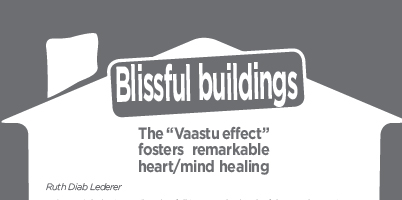 By Ruth Diab Lederer
By Ruth Diab Lederer
On my 8th day in Tamil Nadu, I fell in love … with a building. It captivated me, pulled me in, with stones set in perfect rhythm, decorative elements sculpted in perfect harmony and the exact measure of all elements expressed in perfect balance. My heart attuned to the rays of sunlight dancing with the waves, the shimmering waves of the building’s stone base that flooded my peripheral field and held me in a rapture. Time stood still.
I beheld a centuries-old temple constructed according to the specific methods outlined in the Vaastu Shastras of ancient India, and as I observed it, its luminescence revealed the true nature of its composition.
A fundamental concept articulated in the Prana Veda, authored by Brahmarishi Mayan and preceding the seminal Vaastu Shastras, is that all of creation begins on a subtle level and manifests on the gross. An apple, an alligator and an artist share common, cosmic origins, and they embody distinct physical, energetic patterns based on the mathematics of their forms. Ancient artisans, Vishwakarma Brahmins, initiated the tradition of creating according to the cosmic mathematical formula articulated by Mayan, and they satisfied the ancient world with energetically vibrant artifacts of jewelry, cooking vessels, furniture and buildings. The temple I now love serves as an example of their work, and the traditions are re-emerging with growing interest throughout India and the West. The key element of such creations is that they are “energetically vibrant.”
Vibrancy benefits a person on all levels—spiritual, psychological and physical. In the temple, I experienced the revelation of its wave nature as a profoundly spiritual moment. I witnessed the “proof” of energetic vibrancy in the waves and felt psychological comfort. I stood on the crushed rock of the temple’s ancient birthplace and felt physical stability. Every properly-designed and executed Vaastu structure offers these and many more benefits.
While personal anecdotes hold interest, scientific research seeks to quantify the human experience within Vaastu structures. According to the HeartMath Institute, heart coherence describes a state in which balanced emotions enhance creativity, intuition and focus. Given that these states are on the spectrum of what might be considered blissful, assessing coherence is one way to establish a measurable “Vaastu effect.” When our mental state is stable, our physical state follows.
Dr. Jessie Mercay, Chancellor of the American University of Mayonic Science and Technology, explains the “Vaastu effect.” In a yet to be published study, she finds a 20-30% heart coherence- a typical measure for the general population—prior to occupying a meditation-size Vaastu cottage. After a 20-minute stay in a cottage, a second heart coherence measurement reveals an increase for every subject—often double the initial rate.
A blissful state born of the “Vaastu effect” is the intended result of perfect execution. Human forms benefit spiritually, psychologically and physically from the mathematics of Vaastu-designed forms. These age-old traditions are taking root in the Chicago area. Indeed, planning is underway to build several Vaastu cottages for meditation and/or extra living space in the northern suburbs.
For more, see vaastu.us.com
Ruth Diab Lederer, principal of Vaastu Consultants has studied in the lineage of Dr. V. Ganapati Sthapati at the American University of Mayonic Science and Technology. Ruth was inspired to begin a third career in the field of Vaastu Shastra.

























No Responses to “Blissful Buildings: The “Vaastu Effect” Fosters Remarkable Heart and Mind Healing”